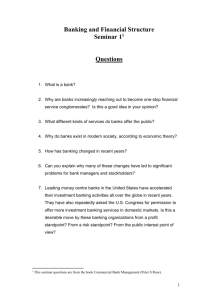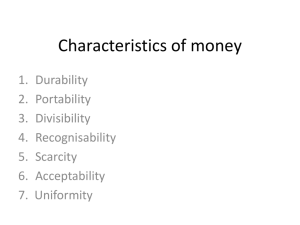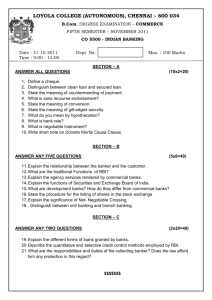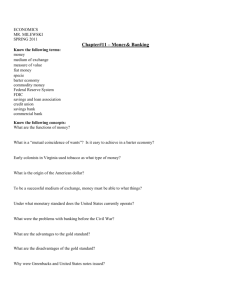Proceedings of 8th Annual London Business Research Conference
advertisement
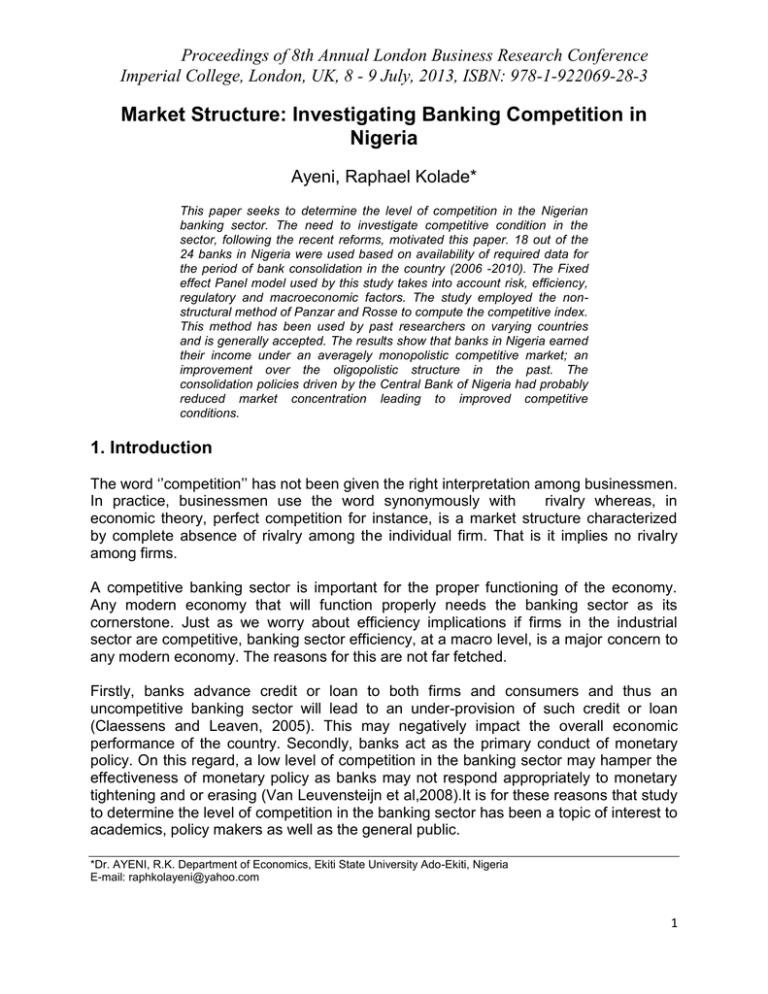
Proceedings of 8th Annual London Business Research Conference Imperial College, London, UK, 8 - 9 July, 2013, ISBN: 978-1-922069-28-3 Market Structure: Investigating Banking Competition in Nigeria Ayeni, Raphael Kolade* This paper seeks to determine the level of competition in the Nigerian banking sector. The need to investigate competitive condition in the sector, following the recent reforms, motivated this paper. 18 out of the 24 banks in Nigeria were used based on availability of required data for the period of bank consolidation in the country (2006 -2010). The Fixed effect Panel model used by this study takes into account risk, efficiency, regulatory and macroeconomic factors. The study employed the nonstructural method of Panzar and Rosse to compute the competitive index. This method has been used by past researchers on varying countries and is generally accepted. The results show that banks in Nigeria earned their income under an averagely monopolistic competitive market; an improvement over the oligopolistic structure in the past. The consolidation policies driven by the Central Bank of Nigeria had probably reduced market concentration leading to improved competitive conditions. 1. Introduction The word „‟competition‟‟ has not been given the right interpretation among businessmen. In practice, businessmen use the word synonymously with rivalry whereas, in economic theory, perfect competition for instance, is a market structure characterized by complete absence of rivalry among the individual firm. That is it implies no rivalry among firms. A competitive banking sector is important for the proper functioning of the economy. Any modern economy that will function properly needs the banking sector as its cornerstone. Just as we worry about efficiency implications if firms in the industrial sector are competitive, banking sector efficiency, at a macro level, is a major concern to any modern economy. The reasons for this are not far fetched. Firstly, banks advance credit or loan to both firms and consumers and thus an uncompetitive banking sector will lead to an under-provision of such credit or loan (Claessens and Leaven, 2005). This may negatively impact the overall economic performance of the country. Secondly, banks act as the primary conduct of monetary policy. On this regard, a low level of competition in the banking sector may hamper the effectiveness of monetary policy as banks may not respond appropriately to monetary tightening and or erasing (Van Leuvensteijn et al,2008).It is for these reasons that study to determine the level of competition in the banking sector has been a topic of interest to academics, policy makers as well as the general public. *Dr. AYENI, R.K. Department of Economics, Ekiti State University Ado-Ekiti, Nigeria E-mail: raphkolayeni@yahoo.com 1 Proceedings of 8th Annual London Business Research Conference Imperial College, London, UK, 8 - 9 July, 2013, ISBN: 978-1-922069-28-3 Despite the importance of such competitive research, there have been very few studies in the literature addressing the issue of competition or the structure of banking industry in Nigeria. Majority of studies on banking industry in Nigeria tend to concentrate on banking sector and economic growth. Studies like Balogun (2007), Tuuli (2002), Elbadaisi (1992), Fadere (2010) are all examples. As a result, there remains a major gap in the economics of banking in Nigeria. What market structure prevails in the banking industry in Nigeria is a major question this study tends to answer. Many authors such as, (Demsetz 1973), Berger (1995) and Mullineux and Sinclair (2000), have given much criticism to using structural methods when measuring competition in the banking sector. This paper therefore focuses on non-structural forms of measurement which takes into account that banks behave differently depending on the market structure in which they operate (Baumol 1982). Two models were used in this study to ensure that the results of one model were not inaccurate due to data or model issues. The non-structural model of Panzar and Rose (1987) approach were used both at the short run and long run forms. This paper is organized as follows; Section 2 discusses the development in the banking sector in Nigeria and Review of some literature. Section 3 discusses the various theories and methods used to measure competition and; gives a detail discussion of the Panzar and Rosse approach. Section 4 provides the analysis and results of the Panzar and Rosse methodology. Section 5 makes a comparison between the results of this paper to outcomes found in comparable developed and developing economies. Finally, section 6 concludes the paper. 2. Structure of Nigerian Banking System According to Bello (2003), the structure of Nigerian banking system earlier, were fragmented in terms of the number and size of institution, ownership pattern, profitability and competitiveness. Added to this was the oligopolistic nature of the industry where very few banks dominated the scene in terms of assets base, profitability and deposit structure, with others being followers and competing for a narrow segment of the market. The banking industry then consists of mainly two types of services, retail and wholesale. Retail banking is focused towards small group or individuals while the wholesale banking caters for larger organization and other financial institutions. 2 Proceedings of 8th Annual London Business Research Conference Imperial College, London, UK, 8 - 9 July, 2013, ISBN: 978-1-922069-28-3 Table 1.0: Previous Macroeconomic Policies in Nigeria Banking. (Before 19531976) Year Structure and Policy detail Before Banking in Nigeria was completely unregulated. 1952 CBN identified a total of 22 banks as being registered between 1947 and 1952. There were several bank failures and attendants losses to depositors. 1952 Banking Ordinance was ineffective as there was no central Bank to act lender of last resort. 1954 Nigeria experienced rapid expansion of indigenous banking companies. This was quickly followed by a high rate of bank failures which has claimed 21 of the 25 established banks. 16 of them collapsed alone in 1954. 1958 The central Bank of Nigeria was subsequently established by virtue of the Central Bank Act of 1958. 1969 Due to the perception of foreign monopoly of the banking sector, the Banking Act of 1969 was enacted. This requires all banks to be locally incorporated and to publish their balance sheets on their Nigerian banking business only. Other regulations were also made. 1972 The Nigerian enterprise Promotion Decree was promulgated to restrict foreign ownership of the Nigerian business to a maximum of 60%. 1976 An amendment to the decree was promulgated to further restrict foreign ownership of Nigeria business to 40%. The adoption of the IMF-led structural adjustment program in 1986 which included a broad program of financial liberalization with interest rate and entry into the banking system liberalized, did not provide any significant improvement in Nigeria‟s key economic indicators as gross domestic product (GDP) at 1980 constant prices declined by 14.3% i.e from 7.5% in 1988 to 6.5% in 1989, while inflation rate increased from 34.5% in 1988 to 50.5% in 1989. In order to improve this situation, the country allowed the establishment of foreign banks in 1990. This resulted in an increase in the number of banks from 106 to 155 by the end of 1997. 3 Proceedings of 8th Annual London Business Research Conference Imperial College, London, UK, 8 - 9 July, 2013, ISBN: 978-1-922069-28-3 Table 2.0: The Macroeconomic Policies in Nigeria Banking (1997 – 2012) Year Policy Detail 1997 CBN lifted restrictions on equity ownership of individual and corporate invention in Nigeria banks. Individual or corporation can own 100% of the share capital which was formally 10% and 30% for individuals and companies respectively. 1998 Due to the distress plagued many of these banks, the number of banks declined to 89 as the federal government liquidate 27 ailing banks. 1999 Policies were introduced at this time when the inflation rate had reduced to 13%, CBN minimum rediscount rate increased to 20.7%. The policies focused on the pursuit of a low interest rate regime in order to support the real sector of the economy, particularly efforts to narrow the gap between savings and lending rates. 2004 Consolidation program began, with the need to strengthen the banks. Banks were consolidated through mergers and acquisition, raising the capital base from N2 billion to a minimum of N25 billion, which reduced the number of banks from 89 to 25 in 2005. In the process of meeting the new capital requirements, banks raised the equivalent of about US$ 3 billion from the domestic capital market and attract about $652million of FDI into the sector. 2006 The CBN replaced the minimum rediscount rate (MRR), The rate it discounts debt instruments with the minting policy rate (MPR). 2010 The asset Management Corporation of Nigeria (AMCON) was established following the promulgation of its enabling Act by the National Assembly. This is to address the problem of non-performing loans. 3. Literature Review So many researchers have concentrated on the measurement of competitive condition in banking industry across global economy, but few in Nigeria. Mulyaningsih and Daly (2011) examined the issue of competition in banking industry of Indonesia, exploiting an unconsolidated annual financial report of all commercial banks between 2001 and 2009. They employed the Panzar –Rose method to examine the banks behavior in competition. Their results indicated that banks in all three subsamples, large, medium sized and small are working in a monopolistically competitive market. The study also showed that the most competitive market was the medium sized banks because it was least concentrated. Greenberg and Simbanegavi (2009), tested for competition in the South Africa banking sector. Two non-structural method of measurement, namely the Panzar –Rose approach and the Bresnaham model were employed by their study. The results of both of these non-structural models showed that the South African banking sector faces a high level of monopolistic competition, even characteristics of perfect competition. Also, Simpasa (2011), conducted a similar study on the competitive condition in the Tanzanian Commercial Banking Industry. The study utilized a rich bank level data set, and employed the Panzar-Rose methodology to compute the competitive index, taking into account risk, efficiency, regulating and macroeconomic factors. Their results 4 Proceedings of 8th Annual London Business Research Conference Imperial College, London, UK, 8 - 9 July, 2013, ISBN: 978-1-922069-28-3 showed that banks in Tanzania earned their income under conditions of oligopolistic conduct. Mathew, Murinde and Zhao (2007) investigated competitive conditions in the UK between 1980 and 2004 using Panzar-Rosse industrial organization approach. The model posits that if the market is contestable, entry to and exit from the market will be easy (even if the concentration of market share among firms is high), so that the prices will be set equal to marginal costs. The study also employed panel data regression model. The null hypothesis that the bank fixed effects are jointly zero was rejected at 1% significance level for the full sample and for the second sub-sample but not at all for the first sub-sample. This indicates the usefulness of the fixed effects panel model that allows for bank heterogeneity. The equilibrium test conducted also shows that the market appears to be sufficiently in a state of equilibrium. The value of the contestability parameter H, falls subsequently, suggesting that the degree of competition in UK retail banking weakened over the period. The study concluded that the market in UK is best characterized by monopolistic competition rather than either perfect competition or pure monopoly. Fadere (2010), investigated the effect of banking sector reforms on economic growth in Nigeria over the period 1996-2009 using the ordinary least square regression technique. The study established a strong and positive relationship between economic growth and the total banking sector capital. But the study failed to establish the level of competition among the banks in Nigeria. 4. Methodology This study used the Panzar and Rosse (1987) approach to measure competition in the Banking sector. This approach measures competition on panel data by comparing the properties of each bank‟s reduced from revenue equation across time. Two of the important assumptions underpinning this model are (i) that banks operate in their long run equilibrium and (ii) banks hold a homogenous cost structure. This model measures the level of competition by establishing how each of the individual banks‟ revenues reacts to proportionate changes in input prices. If the banks act as monopolies or at least in a monopolistic manner, and they face positive marginal costs, they will produce where demand is elastic. An increase in input prices will increase marginal costs, causing equilibrium output to decrease and equilibrium price to increase. Given that their elasticity of demand is greater than unity, the increase in prices will result in a reduction in the total revenue of the banks. This reduction in revenue reveals that banks are acting in an anticompetitive manner (Greenberg and Simbanegari; 2009). The empirical investigation consists of deriving an index (the Panzar – Rosse H – statistic) of the sum of the elasticity‟s of revenues to factors costs (input prices). If this lies between 0 and 1, we have monopolistic competition or a partially contestable equilibrium, whereas H < o would imply a monopoly and H = 1 would imply perfect 5 Proceedings of 8th Annual London Business Research Conference Imperial College, London, UK, 8 - 9 July, 2013, ISBN: 978-1-922069-28-3 competition or perfect contestability. The key point is that if the market is characterized by perfect competition, an increase in input prices will not affect the output of firm‟s while it will under monopolistic competition. Panzar and Rosse have defined an h-statistic as the sum of the elasticity of the banks‟ revenue with respect to a change in each of m factor input prices. The H- statistic is therefore m Ri* wki H . . * w k 1 . ki Ri Where Ri* the equilibrium revenue for bank i wki = input prices of factor k for bank i The H – statistic derived by Panzar and Rosse is positively related to the level of competition in the banking sector. The summary of the testable hypotheses of the theory are provided in table 3.0 Table 3.0: The Panzar – Rosse H – statistic outcomes Estimated H Competitive Environment/ Equilibrium H ≤0 Monopoly/colluding Oligopoly – Each bank operates under monopoly profit maximizing conditions. H is a decreasing function of the perceived demand elasticity O<H<1 Monopolistic competition – free entry but where banks operate with some excess capacity. It is an increasing function of the perceived demand elasticity. H=1 Perfect competition – free entry with full capacity utilization. Source: Greenberg. J.B et al (2009) The reduced form model for the revenue equation applied to this study is stated as nREV it 0 1nPEX it 2 nPCPit 3 PFDit 1nEQTAS it 2 nNLTAS it ............. .......... 3 nDEPSTit 4 nCIRT iINF i vit ...(1) REV = bank revenue for firm i at time t. PEX = personnel expenses to employers (the unit price of labor) which in interest expense per Total deposit. PCP = ratio of capital assets to fixed asset (the unit price of capital). PFD = the ratio of annual interest expenses to total loanable funds (the unit price of funds) Independent variables are given by bank specific factors denoted by: NLTAS = Net loan to Total Asset ratio. This is a bank specific risk-taking element of Nigeria banks, reflecting both credit and interest rate given the special features of loans in a bank‟s portfolio. EQTAS = Equity to Total Asset ratio. This is the proportion of bank equity to total assets. 6 Proceedings of 8th Annual London Business Research Conference Imperial College, London, UK, 8 - 9 July, 2013, ISBN: 978-1-922069-28-3 DEPOSIT = Total market customers‟ deposits to control for aggregate local demand for banking services or deposit penetration intensity on the degree of bank competition. CIRT = Cost-to- income Ratio aimed at capturing efficiency gains on revenue and hence degree of competitiveness. The co-efficient of CIRT is expected to be negative, indicating that inefficiency performance limits bank‟s competitiveness conduct. INF = Inflation rate, which represents the effect of macroeconomic condition and stance of monetary policy on bank performance. It is also expected that the coefficient of INF be less than zero. A high rate of inflation negatively affects bank‟s revenue performance and lowers the level of competitive conduct. µi = bank-specific fixed effect error firm vit = idiosyncratic disturbance term. The contestability parameter, H, is given as H=1 + 2 One of the assumptions of the Panzar-Rosse approach is that it is valid when applied to a banking market in the long-run equilibrium. Hence a test was conducted to this effect. The test for long-run equilibrium is given by Equation 3 with ROAA denoting the returning on average assets adjusted to account for possibility of negative profit rates. nROAAit 0 1nPEX it 2 nPCPit 3 PFDit 1nEQTAS it 2 nNLTAS it ............. .......... 3 nDEPSTit 4 nCIRT iINF i vit ...(2) Equilibrium is argued to exist in the market if E= 1+ 0 If E ≤0, there is disequilibrium, otherwise, there is equilibrium. 1 2 1 3 5. Sample and Data For the sample and data, the study focuses on the latest time period of consolidation and available data (2006-2010). Bank level data and used for 18 banks out of the 24 banks in Nigeria. The reason was that, only the 18 banks have full financial summary for the period under study. The data were sourced from the BGL Banking Reports, an internationally credible source. 6. Findings The results for test of equilibrium are given first in table 4.0. 7 Proceedings of 8th Annual London Business Research Conference Imperial College, London, UK, 8 - 9 July, 2013, ISBN: 978-1-922069-28-3 Table 4.0: Fixed Effect Estimation Result of Market Equilibrium of Nigerian Banks. Variable Coefficient Std. Error p-value Constant 3.8746*** 2.1880 0.0813 Ln PEX 0.1618 0.2920 0.5814 LnPCP 0.0921 0.12770 0.4731 LnPFD -0.2247 0.2633 0.3966 Ln(EQTAS) 0.0898 0.2352 0.7038 Ln(NLTAS) -0.2987 0.2953 0.3156 Ln(DEPOSIT) -0.2168 0.1519 0.1582 Ln(CIRT) -0.7601** 0.3101 0.0170 LnINF -0.5438 0.3120 0.861 Dependent variable: ln ROAA E= 0.029 R2= 0.46 H0: = 0: F(8,90)= 2.20* H0: E = 0; F (1, 90) = 2.68 prob = 0.0590 *Significant at 1%; ** significant at 5%; *** significant at 10% level. The null hypothesis that the bank fixed effects are jointly zero (H0: = 0) is rejected at the 1% significance level (p value = 0.0059). This indicates the usefulness of the fixed effects panel model that allows for bank heterogeneity. The main focus of interest in table 3 is the equilibrium test, and this is given as E = 0.029. The F-test for this shows that E is not significantly differently from zero at 5% level. Since E is not significantly different from zero, it shows that the market appears to be sufficiently in a state of equilibrium that it is valid to continue to investigate the extent of competition using the Panzar-Rosse methodology. Furthermore, the non-rejection of the long-run equilibrium hypothesis (H0: E =0 ) in the Nigerian Banking sector means that the net income as a share of total assets is not connected with input prices. It is to be noted here that our hypothesis of long-run equilibrium holds for the full sample. 8 Proceedings of 8th Annual London Business Research Conference Imperial College, London, UK, 8 - 9 July, 2013, ISBN: 978-1-922069-28-3 Table 5.0: Test of Banking Market Competition with Fixed Effect Variable Coefficient Std Error p-value Constant -0.6638 1.5095 0.6616 PEX 0.5693** 0.2014 0.006 PCP 0.0771 0.0881 0.3845 PFD -0.2209 0.1816 0.2284 EQTAS 0.0546 0.1622 0.7372 NLTAS -0.0605 0.2037 0.7672 DEPST 0.9487* 0.1047 0.0000 CIRT -0.3660*** 0.2139 0.0920 INF 0.2877 0.2152 0.1861 Dependent variable : lnREV R2 = 0.84 H0:= 0 F(8,90)= 13.726* prob = 0.000 H0:H = 0; F (1, 90) = 0.7415 Due to the short span of the sample, the long-run equilibrium could not be tested for individual years. The results of the contestability test using the Panzar-Rosse methodology are presented in table 5.0. The value of the contestability parameter, H, which is the sum of the input elasticities, is given as 0.65 in table 4. The F- statistic for H supports the fact that the contestability parameter is significant at 5% level. This implies that the banking market in Nigeria is best characterized by monopolistic competition since 0<H<1. The independent variables adequately explain the regression as given by the overall Fstatistic. Furthermore, with the exception of the risk-taking element (NLTAS), all other bank specific explanatory variables have expected signs. Also, equity to total asset ratio (EQTAS), is not significant. This suggests that Nigerian banks are not constrained by regulatory burden in their competitive conduct. The negative sign and the insignificance of NLTAS can be interpreted further. This suggests that banks exposure to credit risk has a limited impact on the bank‟s revenue generation and hence competitiveness. This could also project the importance of risk free treasury sections in Nigerian banks. The estimated coefficient in DEPST is highly significant. This suggests that deposit intensity and market demand for bank services in critical to the bank‟s competitiveness. Banks with a large deposit base tend to generate more revenue by intermediating these funds into loans and other interest bearing investments. The coefficient of CIRT, a measure of bank efficiency, carry the expected negative sign and significant at the 10% level. Banks with lower CIRT are termed more efficient. This 9 Proceedings of 8th Annual London Business Research Conference Imperial College, London, UK, 8 - 9 July, 2013, ISBN: 978-1-922069-28-3 result suggests that in the Nigerian banking market, banks with lower CIRT performed better and were therefore well positioned to compete more favorably than the less efficient banks in the market. The effect of macroeconomic uncertainly, proxied by the rate of inflation (INF) is positive but not significant. This suggests that inflationary pressure do not significantly affect the revenue generation of Banks in Nigeria, hence the competitions. As earlier discussed, the degree of competitiveness, given by the magnitude of the estimated H – statistics confirms the existence of monopolistic completion in the Nigerian banking market. This means that, bank‟s revenue were sufficiently sensitive to input cost thereby signaling some degree of competitive pressure at play in the Nigerian banking sector. This result is consistent with previous studies in developing countries, especially Simpasa (2011) for Tanzanian Banking sector, Greenberg et al (2009) for South African Banking sector and Mulyaningsih, et al (2011) for Indonesian banking sector. 7. Conclusion This paper examined the nature of competitive condition in the Nigerian Banking sector between 2006 and 2010 using the Panzar- Rosse methodology. The estimated competitive indicator, the H- statistic derived from a revenue equation shows that the market structure in which banks in Nigeria operate can be characterized by monopolistic competition. The finding goes along with previous research results, particularly in developing countries. Some of the findings of previous empirical results are presented in Appendix 1. However, given the averagely high magnitude of the competitive index in Nigeria banking sector, there is scope for development and deepening of the degree of competitiveness of the sector. Regulatory authorities, the Central Bank of Nigeria, should further explore opportunities that enhance bank‟s competitiveness especially given the on-going banking reforms in the country. Such measures as, consolidating the macroeconomic environment for banking services and encouraging the spread of banking services to remote areas to allow bank accessibility. References Balogun, E.D 2007. “A review of Soludo‟s perspective of banking sector reforms in Nigeria”, MPRA Paper 3803, University Library of Munich, Germany. Basmol, W. 1982. “Contestable Market: An Uprising in the Theory of Industry Structure. American Economic Review,” Vol. 72, 1-15. 10 Proceedings of 8th Annual London Business Research Conference Imperial College, London, UK, 8 - 9 July, 2013, ISBN: 978-1-922069-28-3 Berger, A.N 1998. “The Efficiency Effect of Bank Merger and Acquisition: A Preliminary look at the 1990s Data”, in Bank Merger and Acquisition, eds Y, Amihud and G. Miller, Amsterdam; Kherer Academic publisher. Bresnahan, T. 1982. The Oligopoly Solution Concepts is Identified: Economics Lectures 10, 89-92. Classews, S and L, Laeven 2004, “What Driven Bank Competition? Some International Evidence”. World Bank Policy Research Paper. No. 313, August. Demsets, Harold 1973. “Industry Structure, Market Rivalry, and public Policy. Journal of Law and Economics”, vol. 16, April. pp 1-10. Elbadaw, I. A. 1992 “Macroeconomic Management and the black market for foreign exchange in Sudan”, The World Bank Countries Economics Department Working paper series 859, February 1992. Fadare, S.O (2010) “Recent Banking Sector Reforms and Economic Growth in Nigeria, Middle Eastern Finance and Economics,” Issue 8 (2010), pp. 146-160 Greenberg J.B and W. Simbanegari 2009. Testing for Competition in the South African Banking Sector. Matthews, K, Murinde, V. and Zhao, T 2007. “Competitive Conditions among the major British Banks, Journal of Banking and Finance” 31 (7), 2025-42. Mullineux, A, and Sinclair, P 2000, Oligopolistic Banks: Theory and Policy Implications unpublished. Mulyaingsih, T. and A. Daly 2001.” Competitive Conditions in Banking Industry: An Analysis of the Consolidation, Competition and Concentration in the Indonesia Banking Industry between 2001 and 2009, Bulletin of Monetary Economics and Banking”, October 2011, pp 141-276 Panzer, J.C, and J.N. Ross 1987. “Testing for “Monopoly Equilibrium. The Journal of Industrial Economies”. pp 443-456. Simpaza, A.M. 2011. “Competitive condition in the Tanzanian Commercial Banking Industry, African Development Review”, Vol. 23 (1), pp. 88-98, March Tuuli, Koivu 2002 “Do Efficient Banking Sectors Accelerate Economic Growth in Transition Countries” (December19, 2002) BOFIT Discussion Paper No. 14/2002. Van Leuvenstein, M, Kok- Sorensen, C, Biker, J and Van Rixtel, A 2008. Impact of Bank Competition on the Interest Rate Pass-Through in the Euro Area. Working Paper Series, No 885-European Central Bank. 11 Proceedings of 8th Annual London Business Research Conference Imperial College, London, UK, 8 - 9 July, 2013, ISBN: 978-1-922069-28-3 Appendix 1: H-Statistic for Selected Developing Economies Country Argentina Brazil Chile Colombia Croatia Indonesia Kenya H-statistic 0.73 0.83 0.66 0.66 0.56 0.62 0.58 Country Lebanon Malaysia Mexico Pakistan Paraguay Russian Turkey H-statistic 0.69 0.68 0.78 0.48 0.60 0.64 0.46 Country Ecuador South Africa Turkey Ukraine Poland Russia Sri-Lanka H-statistic 0.68 0.85 0.46 0.68 0.77 0.54 0.71 12
